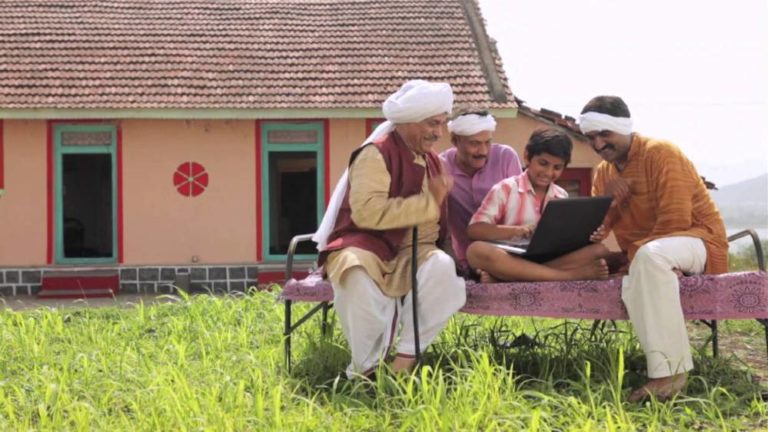An interesting paradox – and this is not new to India – is that despite all of 65% of the population living in rural areas, the rural economy contributes only 46% of the National Income. While this can be seen as a glass half empty, it’s also a glass half full. It reflects the latent potential that lies in rural India, which could become a powerhouse if productivity and consumption levels increased in these regions.
Now as clarified, this disproportionate contribution from rural India is not new; it’s been decreasing gradually over the years, as urbanisation increases. However, it’s on the brink of a shift in gears, which will result in an immense acceleration in rural participation in growth. There are three broad disruptions taking place at the grass-root level in rural India and these are all likely to culminate in a digital consumption revolution.
Digitization of transactions are gaining momentum
Until now, the rural economy has been largely outside the formal financial sector. It has depended on informal sector funding and transactions are largely cash-oriented. The lack of adequate banking facilities in rural areas also endorsed cash as the preferred mode of transactions, until the Jan Dhan Account opening drive. Bank accounts along with access to credit have set the wheels in motion towards digital transactions with far greater frequency and reach. Aadhaar, alongside zero-balance Jan Dhan savings bank accounts, direct transfer of social benefit payments, and the digital payment infrastructure BHIM are just some of the enablers.
Access to smartphones and the internet are key enablers
While this development is touted ad nauseam, its relevance in the upcoming digital consumption revolution cannot be underlined enough. Mobile-first rural Indians have leapfrogged generations of technologies to the mobile phone, which amongst its many ramifications has given them exposure to urban lifestyles. Be it entertainment, access to consumption goods and services, or the convenience of e-wallets, online loans, and digital payments, smartphones and the internet have opened up a whole new world of aspirations for rural India. This impetus is irreversible.
Youth are driving lifestyle change
India’s young demographic is the country’s greatest claim to fame but is also its biggest concern. As things stand, our median age is 28.4 years and a large part of this young population lives in rural areas. Due to this ever-growing source of human capital energy and its aspirations, the agrarian way of life is slowly giving way to multiple income generation opportunities. The rural economy is getting increasingly more diversified, with the non-agricultural sector contributing to about two-thirds of household incomes). Cash flows of rural India, which were relatively unstructured as the rural working population typically worked on the “Earn and Pay” model, are also changing as formal employment and business opportunities that characterise the urban workforce are becoming accessible to rural youth.
According to the IMF’s World Economic Forum (WEF-Jan 2020), the combination of youth, connectedness, education, and multiple income generation opportunities is leading to a surge in rural aspirations and manifesting itself in new consumption choices.
This digital consumption opportunity which is waiting to unfold has also captured the interest of product and service providers and data analysts alike. Technologies like big data analytics, machine learning, blockchain, cloud computing, and artificial intelligence (AI), are increasingly deployed to offer products beyond cities and in rural areas. Side by side, the emergence of fintech companies have improved access to credit and multiple income generation streams are driving consumption.
The WEF report has pointed out the financial requirements of rural customers that are varied depending on their geographical, occupational, and cultural factors, local customs, and aspirations. However, the constraints they face are common. They broadly include unstructured cash flows, which limits access to formal credit; an inherent lack of trust in digital transactions; digital and financial illiteracy; and a strong preference for a face-to-face, touch-and-feel experience. While all these factors are being addressed effectively so that more people become increasingly comfortable with technology and logistics and physical infrastructure are falling in place, it’s an ongoing journey.
So, as things stand, India’s rural customers are not yet ready to go completely digital while accessing finance or in their consumption endeavours. For the time being, physical and digital connectivity also pose as constraints.
The WEF report suggests, Phygitalisation of the rural ecosystem, therefore, is potentially the immediate solution to accelerate rural inclusion.
The report goes on to explain that the dynamic between physical and digital financial services companies is shifting from disruption to collaboration as both bring some compelling strengths to the table. On the one hand traditional financial services providers have a competitive advantage in terms of their knowledge base, experience, existing payment transactions infrastructure, and their compliance and risk operations; building all these will take time as they are not easily replicated. Fintechs, on the other hand, can put new technologies to work and quickly shrink distances, expand customer segments, offer customized experiences and bring in efficiencies on multiple levels. And this holds true for the consumption space as well.
So, on the horizon, it appears that a collaborative and mutually beneficial ecosystem will emerge, which captures the strengths of both physical and digital towards addressing the challenges on the ground more effectively. This will unlock opportunities for inclusive growth much more rapidly and create sustainable economies and societies that leave no one behind.





















